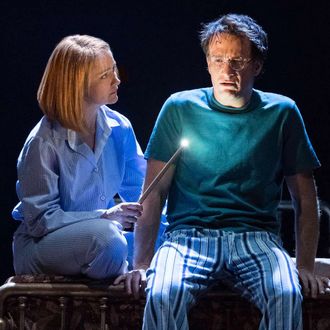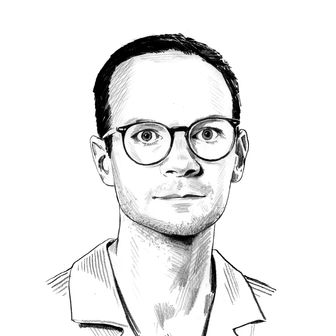
Spoilers ahead for those who haven’t finished Harry Potter and the Cursed Child.
Now that the script of Harry Potter and the Cursed Child has been loosed upon the world, we can talk all we want about the mechanics of the new Potter play. There’s a lot to discuss: Scorpius and Albus’s friendship, the fact that nearly every Potter adult works for the government (or runs a prank store), and the greatness of the Trolley Witch.
But above all, there is Cursed Child’s persistent use of time travel, thanks to the use of an uber-powerful Time-Turner (or pair of Time-Turners, technically) that can carry people years back in time. And, as so often happens when time travel is involved, inconsistencies and questions have resulted. Let’s try to make sense of this.
It seems we’re dealing with two different theories of time travel: In the play, time travel creates alternate futures. In the books, it all occurs in a single loop.
In the play, our main travelers are Albus Potter and Scorpius Malfoy, who jump back in time to the Triwizard Tournament in order to save Cedric Diggory from his untimely death, which happened near the end of Harry Potter and the Goblet of Fire. Much in the style of Back to the Future, Albus and Scorpius’s actions in the past radically alter the future. When they disarm Cedric during the tournament, they also rejigger Ron and Hermione’s romantic history, making Ron end up with Padma Patil and erasing poor Rose Granger-Weasley from existence. In trying to fix that by traveling back to the second stage of the tournament and embarrassing Cedric, they create an even worse future where Voldemort wins.
By depicting this kind of time travel, Cursed Child deviates from the model used in the Potter books, where time travel operates within a closed loop instead of generating alternate timelines. Consider Harry Potter and the Prisoner of Azkaban: Hermione’s Time-Turner only allows her to go back in time for a few hours, and she only uses it to take more classes. Still, at the end of the book, Hermione breaks the rules, going back in time to save Sirius Black and Buckbeak. This all happens in a single loop: Harry and Hermione don’t alter the future so much as ensure that the past all goes in the right order. Before Harry goes back, for instance, a mysterious wizard casts a patronus to save him from some dementors. After time-traveling, Harry realizes that he is that wizard, and casts the patronus himself.
If Cursed Child operated according to the same principle, then Albus and Scorpius’s meddling would be incorporated into the central timeline: They would’ve already meddled in the Triwizard Tournament, and Cedric would’ve already died anyway — sorry, Robert Pattinson.
So if Cursed Child changes how time travel works, is it not Harry Potter canon?
Though J.K. Rowling wrote a great example of single-loop time travel in Azkaban, her descriptions of how time travel works in the Potter world are less consistent. In that book, Hermione mentions that “Professor McGonagall told me what awful things have happened when wizards have meddled with time … Loads of them ended up killing their past or future selves by mistake!” In a post on Pottermore (here’s a screenshot for those without accounts), Rowling describes one witch who got stuck in 1402, and changed the course of the lives of those she met so dramatically that “no fewer than twenty-five of their descendants vanished in the present, having been ‘un-born.’”
To the extent that Cursed Child explains itself, it does give one bit of new time-travel info: Scorpius mentions “Professor Croaker’s law — the furthest someone can go back in time without the possibility of serious harm to the traveler or time itself is five hours.” Perhaps, after that point, the rules of time travel shift. The universe can stitch discrepancies into a single timeline, but big alterations make it change course. That might not be satisfying, but hey, magic!
Going by that admittedly shaky rule, it seems that each successive trip to the past rewrites history, so the alternate futures we see in Cursed Child would simply cease to exist once Albus and Scorpius set things right. As much as those reshuffled Ron-Hermione relationships provide fodder for fanfic writers, everyone should be happily settled in the one central timeline by the end of the play.
If writing about time travel is such a mess, why bother?
Time travel is a notoriously messy subject to bring up in fiction, and J.K. Rowling herself has said that she “went far too light-heartedly into the subject” in the series. In that same Pottermore post, she adds, “while I do not regret [introducing time travel] (Prisoner of Azkaban is one of my favourite books in the series), it opened up a vast number of problems for me.” Rowling quickly had Hermione return her Time-Turner, and later destroyed the Ministry’s entire supply of Time-Turners in the fifth book to help prevent any number of plot holes. “When writing fantasy novels,” she concludes, “one must be careful what one invents. For every benefit, there is usually a drawback.”
Why do Rowling, Jack Thorne, and John Tiffany return to that invention in Cursed Child? Storywise, it allows them to return to some of Potter’s crucial scenes (Voldemort’s attack on Harry’s parents, for instance) and to revive some major characters (oh, hello, Professor Snape). It also lets Cursed Child ratchet up the stakes, but retain the same central conflict, in the now-familiar pattern in so many franchise extensions. Jurassic World had a T. rex, but even bigger; Star Wars: The Force Awakens had a Death Star, but capable of destroying even more planets; Cursed Child has Voldemort, but also Voldemort’s daughter and a whole future subjected to his rule. You wanted “more Harry Potter”; you got “Harry Potter times ten.”
In the Potter universe, by adulthood, the fun is pretty much over. In the play, the adults’ lives, and their relationships, seem to have stalled out – there’s a moving moment where Draco and Ginny mention that they were both jealous of Harry, Ron, and Hermione’s friendship. The new generation, on the other hand, live calmer lives, but always under the shadow of their parents’ accomplishments. “It’s tough,” Delphi says as she seduces Albus in one scene, “to live with people stuck in the past, isn’t it?” The time travel, in the play, seems to stand in for that nostalgia; it’s dramatic shorthand for people corroded by the past. As that time travel proves, if you go back to the past again and again, the world starts to fall apart.





